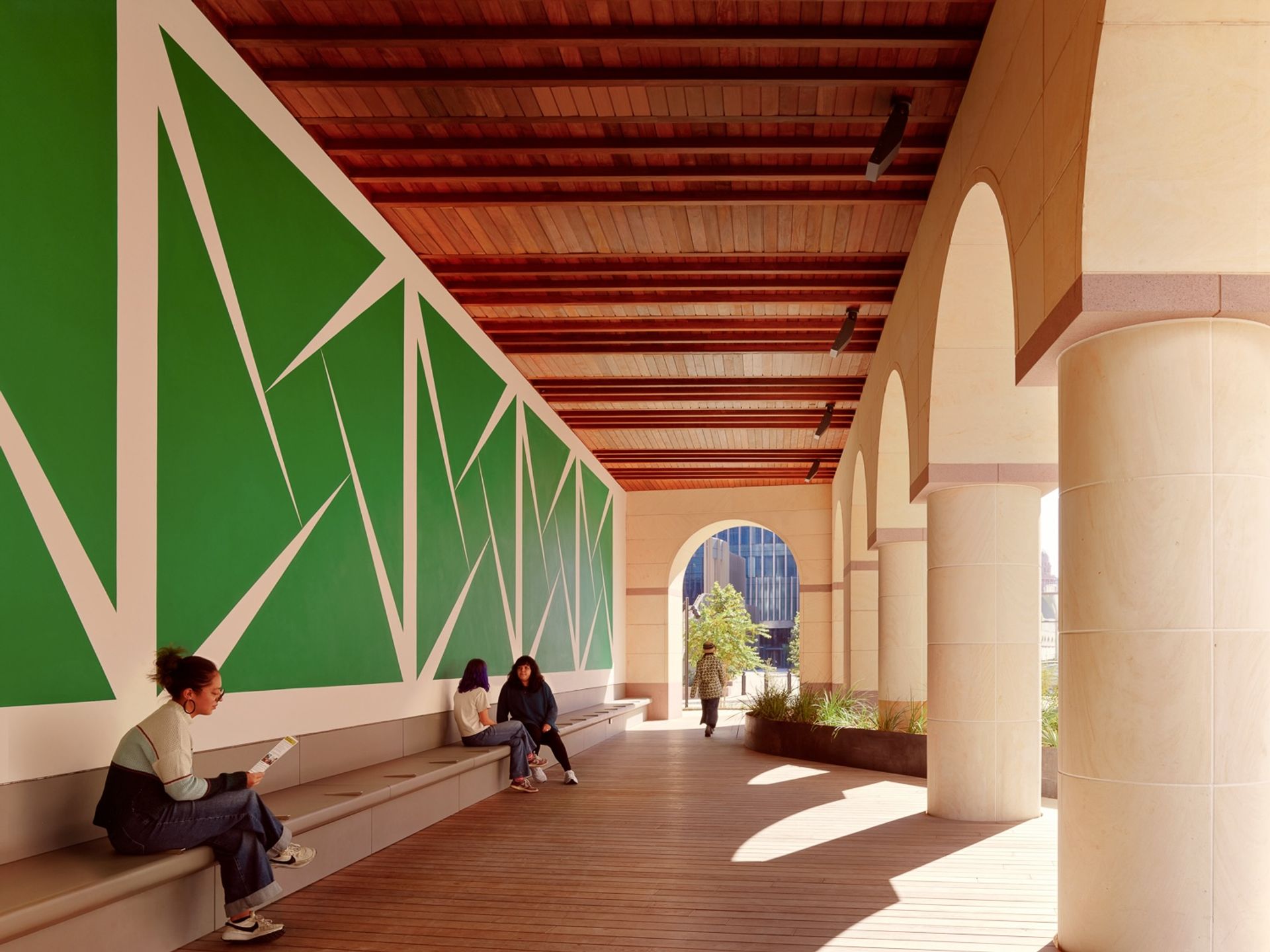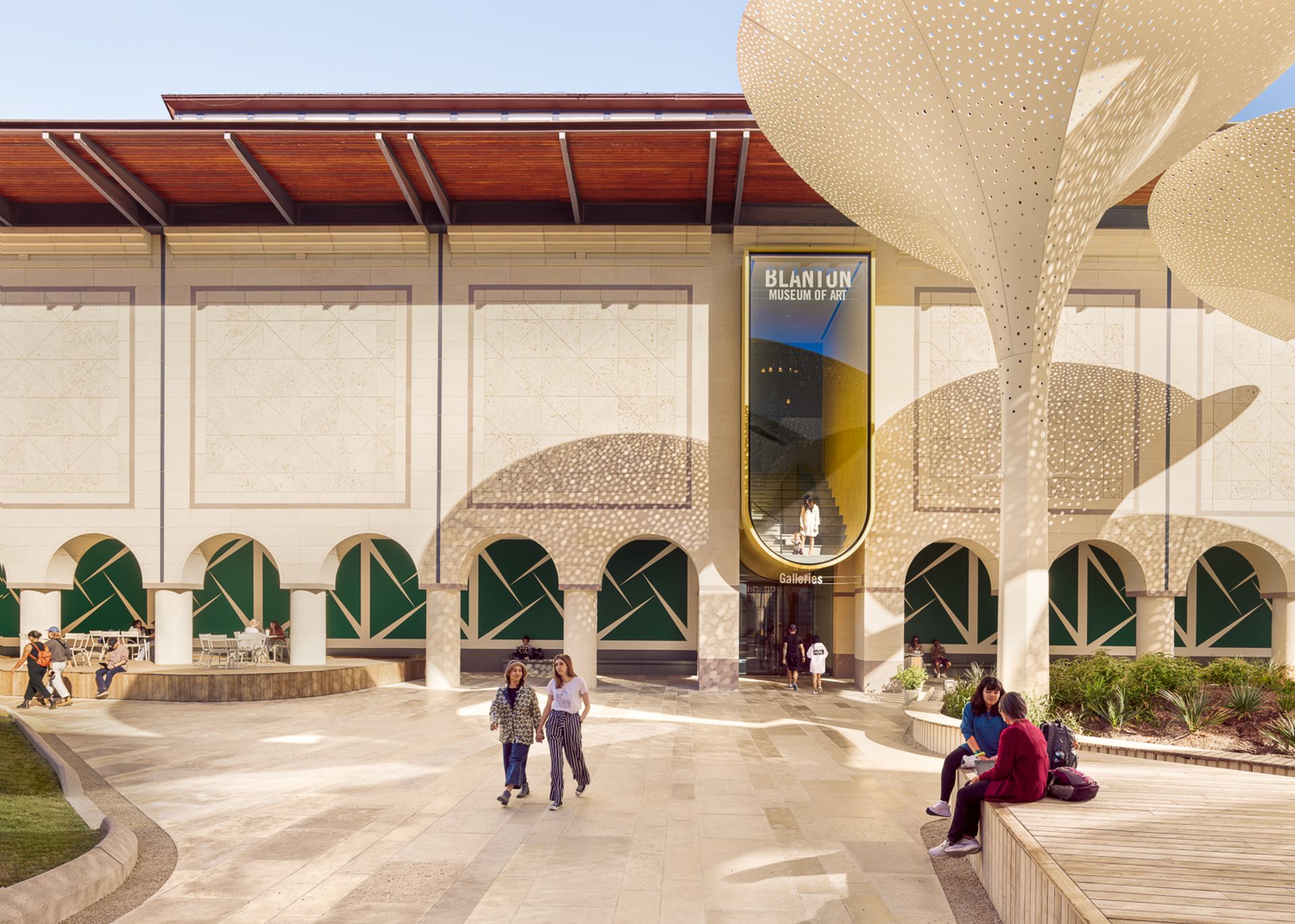The Blanton Museum of Art’s recently completed $35m renovation of its grounds centres on a reimagined outdoor space that acts as both a gateway and a gathering place. Bringing together three major site-specific installations and led by the architecture firm Snøhetta, the redesign makes a statement that there is a museum here at the University of Texas at Austin (UT)—something that was once easy to overlook when its stately but subdued Spanish Revival buildings blended into the campus.
At one end of the museum’s 200,000 sq. ft footprint is Ellsworth Kelly’s Austin, evoking a secular chapel with its coloured glass windows since its installation there in 2018, and on the other are 12 new towering tulip-like shade structures by Snøhetta. Between them is a panoramic mural by the Cuban American artist Carmen Herrera—her only major public mural commission before she died in 2022 at age 106. Visitors now pass through the mural’s centre as they enter the galleries building, which faces the museum’s administration building across this revamped corridor. Called Verde, que te quiero verde (Green, How I Desire You Green), Herrera’s large-scale panels of green slashed with white recall her 1956 painting Green and White, the pinwheeling pattern now framed by the archways of the loggia that span the Blanton.
“There’s an interesting syncopation between the precise geometries and hard lines of the mural and the curvilinear shapes of the loggia that you see from your approach,” says Vanessa K. Davidson, the Blanton’s curator of Latin American art.
Herrera had previously created only two other (smaller) murals, in 2017 and 2020 for New York City Public Schools. Before focusing primarily on abstract painting, Herrera studied architecture at the University of Havana. She expressed her longtime interest in public work in a letter to the Blanton, writing: “The idea of murals always fascinated me as a lover of architecture; it is a delicate balance to any architect or painter. A space is somehow affected or altered by the altering of its surfaces. I love the challenge and respect the responsibility in the choices that are made.”

VIsitors to the Blanton sit in front of Carmen Herrera’s Verde, que te quiero verde (Green, How I Desire You Green) Photo: Casey Dunn, courtesy the Blanton Museum of Art, Austin, Texas
This thoughtfulness in transforming space extends throughout the renovation, such as Snøhetta’s architectural interventions on the museum buildings themselves with two buoyantly yellow vault shapes echoing the loggia arches, one playfully inverted to frame a staircase that acts as an elevated lookout.
Craig Edward Dykers, a co-founder of Snøhetta, studied at UT and drew on that experience. “We wanted to give the school a strong presence for the future, but we also knew that the campus aesthetic was somewhat conservatively focussed on the past,” he says. “Through our knowledge of the campus, we were able to create a completely contemporary narrative with inventive forms and structure, while still incorporating iconic elements of the past—such as the arches of the nearby buildings.”
This renovation project broke ground in March 2021 and was finished earlier this summer, but the Blanton’s metamorphosis from a small teaching museum to an institution presenting art on an international stage happened gradually over time, with the completion of Kelly’s Austin establishing its first exterior landmark six years ago.
Blanton director Simone Wicha says she has been interested in making the museum as much a community as a cultural space since she took the role in 2011. “Most museums have traditionally had these big, soaring atriums,” she says. “These [Snøhetta] shade structures play a really important practical role, but also provide a sense that you have entered into our atrium, and our atrium is, in a very Austin way, this outdoor space that is not singular to the museum experience. People linger, and it’s part of our civic life.”
Although Herrera became involved later in the process, Wicha wanted to specifically assign the commission to a Latin American artist in order to reflect the museum’s major Latin American art collection. In this way, the new exterior elements are in dialogue with the interior galleries.

Snøhetta’s architectural interventions include a playful elevated outlook onto the courtyard, an echo of the original building’s loggia arches (with Herrera’s mural visible in the back) Photo: Casey Dunn, courtesy the Blanton Museum of Art, Austin, Texas
Wicha also sees the museum as being in a larger conversation with the Texas State Capitol, a building directly connected to the Blanton since the 2022 completion of a green pedestrian mall. Especially at a time when budget cuts and proposed legislation continue to threaten the arts, the museum is in a prominent position to showcase the power of creativity—like how Snøhetta’s native-flora landscapes recognise a future of extreme heat and drought. The eye-catching petal structures funnel rainwater to irrigate the plants below, from the spiky-leafed dwarf palmetto to the green grassy bursts of Cherokee sedge.
“We can make the art museum part of a statement on the importance of the arts,” Wicha says, noting that this has extended to working with faculty to bring students from all disciplines into the museum. “One of the things that is really important to me is that the museum be a place like you would think of a library on the campus, it’s just part of your experience.”
That engagement now extends beyond the museum’s walls in unexpected ways, including a dedicated outdoor gallery for sound. Its debut installation is by Bill Fontana, who made field recordings in the Texas Hill Country, such as of cave bats and local birds. This auditory experience gives the grounds a permeable yet distinct feel. Likewise, an elevated walkway that meanders between historic live oaks at the museum’s southern edge is a path for both visitors and commuters on the adjacent Martin Luther King Jr Boulevard.
“We put a lot of thought into this arrival onto campus and this dual mission,” Wicha says. “There are so many ways that you come to the museum, and we wanted to make sure the moment you walked in, you had an art experience and a beautiful, welcoming, clear understanding of where you were.”


